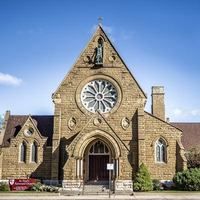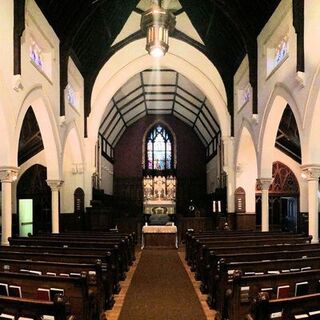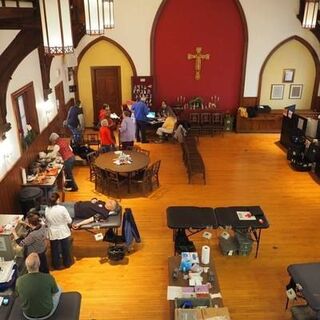We found 4 more Episcopal churches near Muskegon
Who we are
St. Paul’s Episcopal Church was founded in 1866. The second, and current, Gothic Church was completed in 1892. Our sanctuary, with classic design, stained glass windows, Austin organ and Resurrection Chapel create a reverent atmosphere for worship. Within this space we glorify God with sacred music and Eucharist based services ordered by the Book of Common Prayer.
We invite you to browse our website and discover St. Paul’s; our ministries, our faith formation programs, and our historic worship space.
Our ministries offer many ways for parishioners of all ages, backgrounds and skills to participate in the mission of St. Paul’s. We are an inclusive parish, welcoming all, without prejudice, to join our worship and ministry programs.
We invite you to browse our website and discover St. Paul’s; our ministries, our faith formation programs, and our historic worship space.
Our ministries offer many ways for parishioners of all ages, backgrounds and skills to participate in the mission of St. Paul’s. We are an inclusive parish, welcoming all, without prejudice, to join our worship and ministry programs.
Church Address

1006 Third Street
Muskegon,
MI
49440
United States
Phone: (231) 722-2112
Download St. Paul's Episcopal Church vCard with Service Times
Click here to contact the church
Church Pastor

The Rev. Michael Fedewa
Rector
1006 Third Street
Muskegon,
MI
49440
United States
Phone: (231) 722-2112
Download Rector The Rev. Michael Fedewa vCard
Click here to contact The Rev. Michael Fedewa
Denomination
Episcopal Church
Episcopal Churches in Muskegon, MI
Episcopal Churches in Michigan
Episcopal Churches in United States
Episcopal Churches near me
All churches in Muskegon, MI

Affiliations
Church Website
St. Paul's Episcopal Church on Social Media
Leadership
Leader Name:
The Rev. Michael Fedewa
Leader Position:
Rector
Formal Title:
Leader Address:
Phone:
Fax:
Leader Email:
Click here to contact The Rev. Michael Fedewa
Leader Bio:
The Rev. Michael Fedewa on Social Media:
Other Church Leaders:
Leadership Photos
Add a Photo
Administration
Admin Name:
Arabelle Howard
Admin Position:
Parish Administrator
Admin Address:
Phone:
Fax:
Admin Email:
Click here to contact Arabelle Howard
Mailing Address
Driving Directions
Travel/Direction Tips
Know how to get there? Share the knowledge with others!
Parking
Please share parking information and/or parking experience!
St. Paul's Episcopal Church Service Times
Worship Services:
Thursdays 12 noon (chapel)
Sunday 8:00 a.m. (chapel) & 10:30 a.m. (sanctuary)
Other Activities:
Lectionary Bible Study
Thursday - 10:30 a.m. (parlor)
It's been more than 6 years since the last service times update. Please make sure to contact the church to confirm service times.
Please contact the church to confirm Service Times or SUBSCRIBE to updates below
Thursdays 12 noon (chapel)
Sunday 8:00 a.m. (chapel) & 10:30 a.m. (sanctuary)
Other Activities:
Lectionary Bible Study
Thursday - 10:30 a.m. (parlor)
It's been more than 6 years since the last service times update. Please make sure to contact the church to confirm service times.
Please contact the church to confirm Service Times or SUBSCRIBE to updates below
Worship Languages
Dress Code
Sunday School / Children and Youth Activities
Under 12s:
Under 18s:
Local outreach & community activities
Other activities & ministries
Special Needs/Accessibility
Prayers and Hymns
Main Bible:
Hymns and Songs:
Other information
Average Adult Congregation:
Average Youth Congregation:
Additional Info:
St. Paul's Episcopal Church Muskegon Photos
St. Paul's Episcopal Church History
On March 13th, 1866, the Rt. Rev. Samuel Allen McCoskry, first Episcopal Bishop of Michigan, made a visit of exploration to Muskegon and held a service.
Bishop McCoskry was surprised at the growth of Muskegon. He noted the neat residences along the lake, substantial church buildings and twenty-two sawmills in operation. It was a picture of enterprise and thrift which promised a good field for missionary effort.
Inspired by the bishop’s visit, the church folk of Muskegon proceeded to establish services and effect an organization. Articles of incorporation were drawn up and on July 28, 1866, they were signed. St. Paul’s Episcopal Church of Muskegon was born! The Rev. Marcus Lane was the first rector of St. Paul’s.
On June 6, 1867, St. Paul’s was accepted by Diocesan Convention as a parish. On May 19, 1869, three lots at the intersection of Terrace and Peck streets were purchased as a site for the church building. The cornerstone was laid on April 22, 1873. Financial difficulties delayed the church’s completion until late in 1873. It was erected at Peck and Terrace streets, but moved in 1879 to the northwest corner of Webster and Jefferson, because the original site was too far from the downtown community.
Opening services were held on Christmas Day 1873, with the Rev. A.W. Snyder as rector. Consecration took place on April 4, 1875. St. Paul’s was the first church to be consecrated in the new Episcopal Diocese of West Michigan.
Rev. William T. Whitmarsh took charge of the parish on June 26, 1881. Under his direction a tower, spire and entrance porch were added to the Church.
In 1891, the Rev. Philip W. Mosher, curate of St. Paul’s church in Troy, New York, accepted the vestry’s call to be the rector of St. Paul’s Church in Muskegon. Rev. Mosher found a church with “healthy finances and great enthusiasm for building a new church”. The current church site at Third Street and Clay Avenue was bought in 1891. After considering many church plans the vestry chose an Early English Gothic design with a foundation of Bedford limestone and walls of “Green Bluff” stone from Stony Point, Michigan. The cornerstone was laid on September 29, 1892.
Kelly Brothers, of Muskegon, famous for woodworking throughout the Midwest, and contractors for the beautiful carving in the Charles H. Hackley house, made and installed the pews which are still in use today.
The completion of the new church was a tribute to the faith and courage of the vestry and people of St. Paul’s. The lumber industry, on which Muskegon had depended, was practically gone by 1890. Nevertheless, the building was completed and the first service was held on June 6, 1893, in connection with the Diocesan Convention which met in Muskegon on June 6, 7 and 8.
Bishop Gillespie dedicated and blessed the church, noting that his first consecration of a church had been the first St. Paul’s church on April 4, 1875. The church was consecrated on September 11, 1898 after Mr. Thomas Hume paid the balance of St. Paul’s construction debt.
A notable enrichment of the sanctuary came in 1905 when Mrs. Erie L (Hackley) Smith gave as a thank offering an altar of Italian Carrara white marble. It was consecrated on January 28, 1906. Later in 1920, Mrs. Smith gave the mosaic tile work above the altar, the canopy, reredos, chancel window and communion rail.
The beautiful memorial windows in the south transept were placed in May, 1906. They were made in England and were given by Mr. and Mrs. Thomas Hume. In 1921, Mrs. Hume and family replaced the windows in the north transept with those which supplement the ones in the south transept.
Electric lights replaced gas in the chancel in 1906. The property adjoining the church on Clay Avenue was purchased in January, 1922, to provide for expansion. The church interior was completely redecorated in 1924.
The vestry, in April, 1928, was authorized to contract for a new organ, to buy a rectory and to convert the old rectory to a church school and general parish work space. Soon arrangements were made for the organ, a new pulpit, lectern, litany desk, chancel rail and choir stalls. The dedication service for the new organ, chancel woodwork, pulpit and lectern took place on January 25, 1929. Mr. Paul Eickmeyer, organist, gave a recital on the following Sunday to show the power of the Austin organ, then the largest in the Diocese and still in use today.
In July 1946 a committee was appointed to outline a plan for a new Parish House containing the church school, church offices and a chapel. As the study progressed, the committee became convinced that some rehabilitation and revision of the old rectory should be considered instead of building on the vacant Clay Avenue property. On May 23, 1950, a special meeting of the parish authorized the vestry to demolish the rectory, to erect a suitable new building and to remodel existing buildings. Resurrection chapel was completed and consecrated in 1954. The chapel seats fifty and is used mainly for midweek communion, small weddings and private prayer. The church school is in active use to this day and was recently refurbished by volunteers from our congregation in 2006.
“So ends our first hundred years. St. Paul’s had seen many vicissitudes: material ones ranging from a furnace which smoked so badly that the congregation was often in tears, no matter how cheerful the sermon, to the perennial need for money, necessitating mortgages on the property and borrowings from the banks; spiritual discouragements from the lack of a rector at times and apathy of parishioners. Always a devoted band of churchmen and churchwomen had the faith and courage to carry on and to win through to success. May such not be found wanting in the next hundred years.” [1] Written in 1966, St. Paul’s Centennnial Celebration.
[1] Some text and references for this page are from “A Century of Faith, St. Paul’s Episcopal Church 1866-1966” available for review in our Church library.
Bishop McCoskry was surprised at the growth of Muskegon. He noted the neat residences along the lake, substantial church buildings and twenty-two sawmills in operation. It was a picture of enterprise and thrift which promised a good field for missionary effort.
Inspired by the bishop’s visit, the church folk of Muskegon proceeded to establish services and effect an organization. Articles of incorporation were drawn up and on July 28, 1866, they were signed. St. Paul’s Episcopal Church of Muskegon was born! The Rev. Marcus Lane was the first rector of St. Paul’s.
On June 6, 1867, St. Paul’s was accepted by Diocesan Convention as a parish. On May 19, 1869, three lots at the intersection of Terrace and Peck streets were purchased as a site for the church building. The cornerstone was laid on April 22, 1873. Financial difficulties delayed the church’s completion until late in 1873. It was erected at Peck and Terrace streets, but moved in 1879 to the northwest corner of Webster and Jefferson, because the original site was too far from the downtown community.
Rev. William T. Whitmarsh took charge of the parish on June 26, 1881. Under his direction a tower, spire and entrance porch were added to the Church.
In 1891, the Rev. Philip W. Mosher, curate of St. Paul’s church in Troy, New York, accepted the vestry’s call to be the rector of St. Paul’s Church in Muskegon. Rev. Mosher found a church with “healthy finances and great enthusiasm for building a new church”. The current church site at Third Street and Clay Avenue was bought in 1891. After considering many church plans the vestry chose an Early English Gothic design with a foundation of Bedford limestone and walls of “Green Bluff” stone from Stony Point, Michigan. The cornerstone was laid on September 29, 1892.
Kelly Brothers, of Muskegon, famous for woodworking throughout the Midwest, and contractors for the beautiful carving in the Charles H. Hackley house, made and installed the pews which are still in use today.
Bishop Gillespie dedicated and blessed the church, noting that his first consecration of a church had been the first St. Paul’s church on April 4, 1875. The church was consecrated on September 11, 1898 after Mr. Thomas Hume paid the balance of St. Paul’s construction debt.
A notable enrichment of the sanctuary came in 1905 when Mrs. Erie L (Hackley) Smith gave as a thank offering an altar of Italian Carrara white marble. It was consecrated on January 28, 1906. Later in 1920, Mrs. Smith gave the mosaic tile work above the altar, the canopy, reredos, chancel window and communion rail.
The beautiful memorial windows in the south transept were placed in May, 1906. They were made in England and were given by Mr. and Mrs. Thomas Hume. In 1921, Mrs. Hume and family replaced the windows in the north transept with those which supplement the ones in the south transept.
The vestry, in April, 1928, was authorized to contract for a new organ, to buy a rectory and to convert the old rectory to a church school and general parish work space. Soon arrangements were made for the organ, a new pulpit, lectern, litany desk, chancel rail and choir stalls. The dedication service for the new organ, chancel woodwork, pulpit and lectern took place on January 25, 1929. Mr. Paul Eickmeyer, organist, gave a recital on the following Sunday to show the power of the Austin organ, then the largest in the Diocese and still in use today.
In July 1946 a committee was appointed to outline a plan for a new Parish House containing the church school, church offices and a chapel. As the study progressed, the committee became convinced that some rehabilitation and revision of the old rectory should be considered instead of building on the vacant Clay Avenue property. On May 23, 1950, a special meeting of the parish authorized the vestry to demolish the rectory, to erect a suitable new building and to remodel existing buildings. Resurrection chapel was completed and consecrated in 1954. The chapel seats fifty and is used mainly for midweek communion, small weddings and private prayer. The church school is in active use to this day and was recently refurbished by volunteers from our congregation in 2006.
[1] Some text and references for this page are from “A Century of Faith, St. Paul’s Episcopal Church 1866-1966” available for review in our Church library.
St. Paul's Episcopal Church Historical Photos
Add a historical photo
 I ask for...
I ask for...
I ask you neither for health nor for sickness, for life nor for death; but that you may dispose of my health and my sickness, my life and my death, for your glory... You alone know what is expedient for me; you are the sovereign master, do with me according to your will. Give to me, or take away from me, only conform my will to yours. I know but one thing, Lord, that it is good to follow you, and bad to offend you. Apart from that, I know not what is good or bad in anything. I know not which is most profitable to me, health or sickness, wealth or poverty, nor anything else in the world. That discernment is beyond the power of men or angels, and is hidden among the secrets of your providence, which I adore, but do not seek to fathom.
St. Paul's Episcopal Church listing was last updated on the 4th of December, 2018
THANK YOU FOR VISITING ST. PAUL'S EPISCOPAL CHURCH ONLINE!
St. Paul's Episcopal Church Accelerated Mobile Page (AMP)















